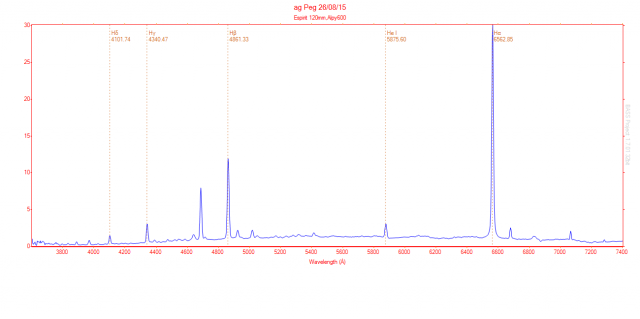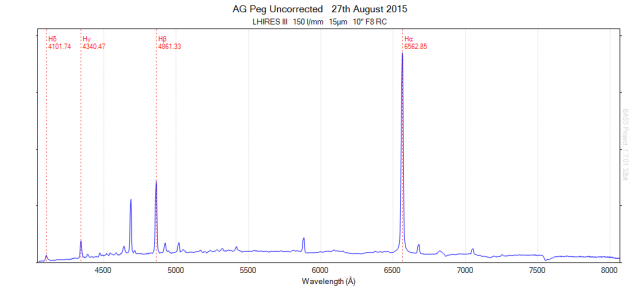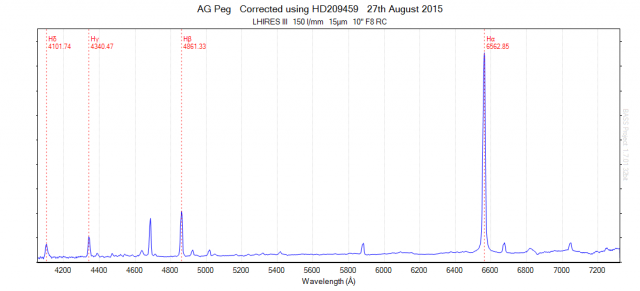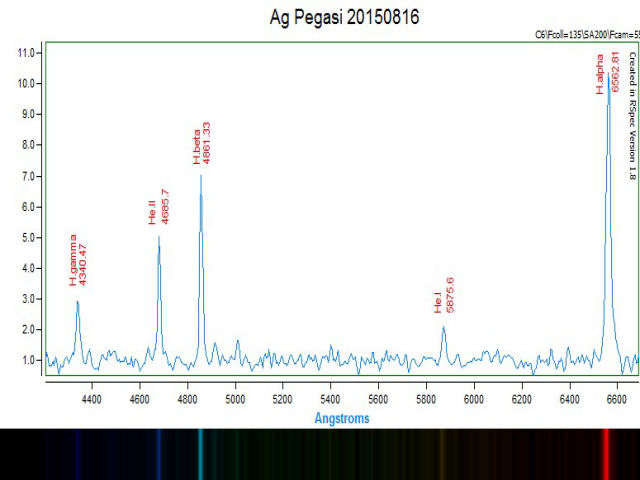› Forums › Variable Stars › Symbiotic ag Peg!
- This topic has 9 replies, 4 voices, and was last updated 10 years, 4 months ago by
 Andy Wilson.
Andy Wilson.
-
AuthorPosts
-
28 August 2015 at 1:07 am #573464
 Steve CuthbertParticipant
Steve CuthbertParticipantHi
Not very clear tonight (26/08/15) but mainly observed to checkout the Windows 10 update on my obs laptop. Tried some spectro with ag Peg last night, Balmer lines very clear.

regards
Steve
Attachments:
28 August 2015 at 2:05 pm #576995 Andy WilsonKeymaster
Andy WilsonKeymasterHi Steve,
Purely by coincidence I observed AG Peg the night after you. I include my uncorrected spectrum, along with a spectrum corrected for atmospheric and instrument response using HD209459. I’m not sure the correction is perfect, but I was having some computer issues that mucked up my guiding.


Best wishes,
Andy
28 August 2015 at 8:38 pm #576996 john simpsonParticipant
john simpsonParticipantHello Andy, Steve,
Thanks to both of you for posting your spectra – they are impressive and in my case certainly of great help because I can compare with my own low resolution spectra using SA200 & DSLR. I have been following Chi Cygni & AG Pegasi [and also CH Cygni] since July/Aug, at low reolution and at other end of learning curve to you. I have used several different references to correct for for instrument and atmospheric extinction effects, but am wondering if I should be using some recognised standard stars that are in common use – depending on target RA/DECL? So far I’ve tried to find a nearby A class star of roughly the same magnitude to use, but is there somewhere a preferred/recommended list?
Best Wishes
john s
28 August 2015 at 8:44 pm #576997 Steve CuthbertParticipant
Steve CuthbertParticipantHi Andy
Thats pretty cool as yours was taken with the Lhires III and there doesn`t seem a great deal of difference between the two!. Quite pleased with that :-).
BTW I tend to use the same spectrum for correcting all the spectra taken that night and not sure if I should really be taking a matching spectrum for each star, is that the way you do it??
best
Steve
28 August 2015 at 8:56 pm #576998 Steve CuthbertParticipant
Steve CuthbertParticipantHi John
Think our posts just crossed. I remember most of the tutorials on spectroscopy recommended the standard spectro `candle` Vega for correcting but as you may have seen in my post above I`m still a bit unsure if I should be using a fresh correcting spectrum for each star, logic would assume that we should for more accurate correction the thing is finding a star of similar class to the one you are observing within a near enough distance away which all takes time and with the British weather we `enjoy` time is not always a luxury we can be sure of!
cheers
Steve
28 August 2015 at 9:45 pm #576999 john simpsonParticipant
john simpsonParticipant Hi Steve,
Hi Steve,Yes, think our posts did cross. I agree too with your logic, would be best if all observers could use same reference, whatever it was agreed to be. Since still experimenting have made note to do comparison based on several references at next available opportunity to see what differences accrue. My efforts for AG Pegasi on 16th Aug. attached. A lot of noise, but H alpha, beta, gamma clear – also some He I & II lines.
28 August 2015 at 10:00 pm #577001 Andy WilsonKeymaster
Andy WilsonKeymasterHi Steve and John,
That is a great spectrum John. These are exciting times as spectroscopy is becoming more easily available to amateurs, and there are plenty of fascinating targets.
My understanding of response correction is that to get a really good atmospheric correction you need to find an A or B star of similar airmass (altitude) to your target star, and with a professional spectrum available. There are ways to get a good compromise, but for the very best results this is the way to go.
There are a couple of very handy resources that make this much easier. First there is the Miles database of standard spectra. Second a spreadsheet that allows you to locate stars from the Miles database of similar airmass to your target at the time of observation. The ARAS forum post on this subject can be found here:
http://www.spectro-aras.com/forum/viewtopic.php?f=8&t=941
Best wishes,
Andy
29 August 2015 at 9:06 am #577002 Andy WilsonKeymaster
Andy WilsonKeymasterI forgot to mention that there is no need to match the spectral class of the reference star with the target star. The reason for choosing A stars, or if not a B star as a reference, is the spectra are very simple. So it is easy to smooth the response curve after dividing the spectra to get a curve that will act as a good response.
A good way to test a response curve is to take spectra of 2 A or B stars in the Miles database at similar airmass (altitude), using one to create the response curve, and then correct the other and compare it with the Miles database. A good fit means you are doing it right, though I still usually find they are not quite the same. Low resolution can be tricky.
I also think using the same reference stars is an excellent idea. It does need to be very close to the target so that its altitude stays similar as the 2 stars track across the sky.
Best wishes,
Andy
30 August 2015 at 5:34 pm #577007 Robin LeadbeaterParticipant
Robin LeadbeaterParticipantAs it happens – Francois Teyssier has just updated his reference star finder for low resolution spectroscopy
http://www.spectro-aras.com/forum/viewtopic.php?f=8&t=1227
It finds the potential reference stars nearest in altitude to your target and now will even plot a trajectory so you can see how the relative altitude changes with time
It now includes all the MILES A and B stars (which have professionally measured spectra) as well as a long list of bright main sequence A and B stars with low interstellar extinction and published spectral classification. These should have spectra similar the generic (eg Pickles) spectra for the particular spectral type but they do not have published spectra so you need to be a little careful using these, perhaps at some point comparing them with a MILES standard for example to confirm they are typical of their type.
I think measuring a few MILES stars of different spectral types is good practice if you are starting out or testing new equipment as any deviations between the measurement and the database version can be seen and followed up to improve one’s technique. There are some examples here where I did this using the Star Analyser and ALPY
http://www.threehillsobservatory.co.uk/astro/spectroscopy_21.htm
I find getting the blue end below ~4000A perfect particularly difficult for a number of reasons:-
the sensitivity of the instrument drops off sharply
any errors due to atmospheric extinction are greater
any problems from selective sampling of particular wavelengths by the slit due to for example atmospheric dispersion or chromatic aberrations in the optics are greater
it is difficult getting enough signal from the (halogen) flat lamp to keep the noise level down
the increased crowding of the Balmer lines towards the Balmer jump makes it more difficult to get a perfect match between measured and reference spectra.
Cheers
Robin
30 August 2015 at 6:11 pm #577008 Andy WilsonKeymaster
Andy WilsonKeymasterThanks Robin. Those are really useful links and information on response correction. I’m starting to get a handle on it but still plenty to learn!
Andy
-
AuthorPosts
- You must be logged in to reply to this topic.
